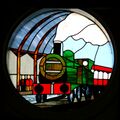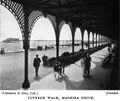Category:Brighton Piers
1965: Photograph of the West Pier (foreground) and Palace Pier (background), aerial view looking East [image info]
1937: Seafront scene with onion-domed pier and bandstand [image info]
Brighton has had three Piers – from East to West, these have been the Chain Pier, the Palace Pier, and the West Pier.
Of these three, only the Palace Pier is still standing.
Brighton's five piers?
If we are willing to stretch a point, we can add two more to the list:
- Brighton's "Daddy Long-Legs" was billed as a seagoing electric railway, but its appearance and construction (and use for sight-seeing) arguably made it more of a mobile tracked pier section than a railway carriage. The project engineer later went on to work on the Palace Pier.
- The i360 sightseeing tower, which is planned to be built on the base of what used to be the West Pier, has been described as being a vertical implementation of the pier concept.
1960 description
THE British are the people of the piers. No other country in the world indulges in pier-promenading. But the British, and particularly the English, are so fond of their seaside piers that many people spend almost the whole of their holidays strolling along them and being entertained there.
Brighton was the pioneer of the pier, building the first in this country as long ago as 1822. The example was soon followed on a wide scale, and today the coastline of 4,600 miles is adorned with 300 piers, all designed to provide pleasure for the holiday maker.
Even today, when the skill of the engineer has become a legend, the building of a pier presents immense difficulties. In fact, pier-building remains a complex undertaking of the first magnitude, being set around with countless problems.
The bed on which the pillars rest has to be excavated against the constant and regular interruptions of the tide and often work must go on below the waves. Exhaustive tests have to be carried out to ensure that the structure will stand up to high seas and fierce winds. Even when the pier is completed, most precise tests must be made to ensure that it can be safely result in a major catastrophe. It is not surprising that the firms which undertake the task of building piers still remain few in number.
In the space of a single season, 1,000,000 visitors stroll and sun themselves on the big piers, and a record was set up at Brighton's Palace Pier in 1947 when 3,000,000 people passed through the turnstiles.
Although the building of piers presents obvious difficulties, the old Brighton Chain Pier was built, so its makers claimed, to stand for 1,000 years. It was not their fault, either, that it lasted by no means as long as that, for its 1,136 feet had the support of massive oak piles. Even these, however, failed to withstand the savage gale which swept Brighton in December 1896 and the pier was destroyed.
It had proved so popular that it was replaced as. speedily as possible. The present Palace Pier was opened in 1899, having cost £137,000 to build. A similar structure today would cost anything up to £3,000,000.
Last year, nearly 250,000 people paid to walk on the Palace Pier, paying well over £5,000 a day for the privilege — most of the money being in pennies. Yet such an income is none too large, for piers are highly expensive things to run and maintain.
The Palace Pier needs 8,500 electric lamps each season, and these cost well over £1,500. Employees' wages take £25,000, and the bands cost up to £5,000. At the height of the season 1,000 people dance in the open air, and a further 2,000 pay to sit and listen to the open-air orchestra.
A mile away is Brighton's West Pier, and there are other piers further along the coast. All need considerable support to make them pay, for the private companies who own them do not spare money in their determination to make them attractive.
Most piers are fitted out like luxury liners, with first-class restaurants, ballrooms, theatres, sun-lounges and funfairs. A single coat of paint costs up to £5,000. In most cases half a pier's structure is scraped, chipped and repainted each year by the pier's own painters. If the whole surface to be covered receives a couple of coats of paint, about 1,000 gallons of colour are spread over it.
In addition to the painters, the pier-owners employ a small army of metal-workers, blacksmiths, plumbers, electricians and carpenters. With so many feet pounding it the deck is subject to swift wear, and the cost of replacing a single yard of it no less than £20. This private staff, which can range from 50 to 100 men, according to the size of the pier, is engaged throughout the whole year and their wages alone may absorb as much as £50,000.
The summer season, however, calls for from 200 to 300 extra workers. These are deck-hands who keep the pier clean, chair attendants who set out between 2,000 and 5,000 deck-chairs a day and collect the money charged for them, and, less noticeable, the firemen who are ready to deal with an outbreak the moment it occurs.
Finally, there are divers who go underwater daily make sure that the feet of the pier remain firmly planted. ...
— , Leslie E. Wells, , Meccano Magazine, , June 1960
Subcategories
This category has the following 3 subcategories, out of 3 total.
Pages in category ‘Brighton Piers’
The following 10 pages are in this category, out of 10 total.
A
B
Media in category ‘Brighton Piers’
The following 73 files are in this category, out of 73 total.
- 1823 - The Chain Pier, showing original entrance (TBCPIM 1896).jpg 3,000 × 1,859; 3.21 MB
- 1824 - An Early Drawing of the Chain Pier (TBCPIM 1896).jpg 3,000 × 1,897; 2.06 MB
- 1824 - The Great Birthday Storm, Chain Pier (TBCPIM 1896).jpg 3,000 × 1,524; 2 MB
- 1833 - The Storm of October 15th, Chain Pier (TBCPIM 1896).jpg 3,000 × 2,005; 2.56 MB
- 1836 - The Chain Pier after the Hurricane of 29th November (TBCPIM 1896).jpg 3,000 × 1,688; 2.7 MB
- 1871 - The Chain Pier after the Removal of the Esplanade (TBCPIM 1896).jpg 3,000 × 1,670; 1.92 MB
- 1896 - The Chain Pier on its Last Legs (TBCPIM 1896).jpg 3,000 × 2,004; 2.47 MB
- 1896 - The Morning after the Storm, Chain Pier (TBCPIM 1896).jpg 3,000 × 1,921; 2.49 MB
- 1896 Chain Pier - Closed, Edward Fogden (TBCPIM 1896).jpg 1,024 × 903; 545 KB
- Big Arm ride, Brighton Pier (May 2016).jpg 1,467 × 2,200; 293 KB
- Brighton By Night, by HG Gawthorn (BrightonHbk 1935).jpg 2,200 × 1,502; 2.44 MB
- Brighton Chain Pier unidentified 2.jpg 600 × 450; 43 KB
- Brighton Chain Pier unidentified.jpg 2,048 × 1,536; 804 KB
- Brighton Chain Pier wrecked 1896, postcard, Clem Lambert (SDNS).jpg 2,000 × 1,248; 1.9 MB
- Brighton Map (VisitBrighton 2014).jpg 1,432 × 3,000; 2.69 MB
- Brighton Palace Pier (2021-08).jpg 3,000 × 2,000; 1.33 MB
- Brighton Pavilion (stained glass at Brighton Palace Pier).jpg 1,600 × 1,600; 288 KB
- Brighton Pier illuminated sign (May 2016).jpg 2,200 × 1,467; 550 KB
- Brighton Pier screen (May 2016).jpg 2,200 × 1,467; 749 KB
- Brighton Pier sign, detail (May 2016).jpg 2,200 × 1,467; 392 KB
- Brighton Pier, seen from the Brighton Wheel, 2014.jpg 2,400 × 1,351; 1.7 MB
- Brighton seafront attractions (Brighton 2018).jpg 3,000 × 1,814; 3.06 MB
- Brighton Station (stained glass at Brighton Palace Pier).jpg 1,600 × 1,600; 219 KB
- Brighton West Pier details (NGB 1885).jpg 800 × 373; 158 KB
- Brighton Wheel, Palace Pier, Volks, Terraces (2014-04).jpg 1,936 × 624; 276 KB
- Carousel and Helter Skelter, Brighton Pier, West Pier distant (May 2016).jpg 2,200 × 1,467; 587 KB
- Chain Pier, Brighton, engraving.jpg 1,200 × 900; 431 KB
- Chain Pier, Brighton, Lego Digital Designer.jpg 819 × 459; 92 KB
- Chain Pier, Brighton, plaque.jpg 1,200 × 804; 674 KB
- Chain Pier, engraving (TNAB 1888).jpg 3,000 × 1,869; 1.52 MB
- Clock, Brighton Pier (May 2016).jpg 1,467 × 2,200; 312 KB
- Covered Walk, Madeira Drive, view East (BHAD10ed 1933).jpg 1,800 × 1,530; 1.56 MB
- Covered Walk, Madeira Drive, view West (BHAD10ed 1933).jpg 1,800 × 1,517; 1.52 MB
- Crazy Mouse ride, Brighton Pier (May 2016).jpg 2,200 × 1,467; 582 KB
- Electric Railway near Black Rock, Brighton, postcard 18.jpg 3,000 × 1,910; 4.9 MB
- Hove Seafront, aerial (HoveIG 1936).jpg 1,837 × 2,500; 3.68 MB
- Kings Road, Brighton, looking East (BHAD10ed 1933).jpg 3,000 × 1,768; 3.08 MB
- Malvern Private Hotel, Regency Square, West Pier (BHOG ~1961).jpg 1,800 × 1,192; 1.02 MB
- Palace Pier (BHAD10ed 1933).jpg 3,000 × 1,809; 3.05 MB
- Palace Pier Brighton, 35 Years of Progress (RoyalJubileeSP 1935).jpg 1,200 × 856; 290 KB
- Palace Pier Brighton, Inaugural Ceremony 1891 (RoyalJubileeSP 1935).jpg 2,998 × 2,263; 1.65 MB
- Palace Pier, Brighton, angle view.jpg 1,200 × 900; 724 KB
- Palace Pier, Brighton, side view, East.jpg 1,200 × 900; 832 KB
- Palace Pier, Brighton.jpg 1,200 × 676; 319 KB
- Pavilion Gardens (stained glass at Brighton Palace Pier).jpg 1,600 × 1,597; 234 KB
- Pier at sunset (stained glass at Brighton Palace Pier).jpg 1,600 × 1,600; 213 KB
- Seagull, Brighton Palace Pier (Brighton 2018).jpg 1,777 × 1,783; 1.01 MB
- The Chain Pier (NGB 1885).jpg 1,200 × 799; 193 KB
- The Old Chain Pier, Brighton (RB).jpg 3,000 × 1,896; 4.53 MB
- The Old Chain Pier, Brighton, colourised (postcard, old, unclaimed).jpg 1,024 × 643; 290 KB
- The Old Chain Pier, Brighton, postcard (GDD).jpg 3,000 × 1,904; 3.29 MB
- The Palace Pier at Night (BHAD10ed 1933).jpg 3,000 × 1,825; 3.03 MB
- Turbo ride, Brighton Pier (May 2016).jpg 2,200 × 1,467; 456 KB
- View inland from the West Pier, Brighton (postcard, old, unclaimed).jpg 1,024 × 643; 391 KB
- West Pier and Donkey (postcard, old, unsourced).jpg 1,024 × 640; 340 KB
- West Pier and Palace Pier (STH 1965).jpg 1,402 × 1,052; 1,003 KB
- West Pier salvage space.jpg 1,200 × 429; 197 KB
- West Pier Sundeck (BHOG ~1961).jpg 3,000 × 1,631; 2.67 MB
- West Pier, 1939 map (BrightonHbk 1939).jpg 1,199 × 1,200; 447 KB
- West Pier, Brighton, early, detail.jpg 600 × 450; 80 KB
- West Pier, Brighton, early, unidentified.jpg 600 × 450; 60 KB
- West Pier, Brighton, engraving (FA 1881).jpg 2,200 × 1,230; 596 KB
- West Pier, closeup.jpg 1,080 × 696; 89 KB
- West Pier, engraving (TNAB 1888).jpg 3,000 × 1,982; 1.37 MB
- West Pier, kiosk.jpg 1,600 × 1,600; 1.95 MB
- West Pier, landing section.jpg 1,200 × 900; 649 KB
- West Pier, landing, roof.jpg 1,600 × 902; 1.09 MB
- West Pier, landing.jpg 1,600 × 901; 1.18 MB
- West Pier, moody.jpg 1,600 × 1,200; 1.6 MB
- West Pier, sunlit.jpg 1,600 × 900; 1.14 MB
- West Pier, temple.jpg 1,600 × 899; 1.14 MB
- West Pier, uprights.jpg 1,600 × 1,200; 1.43 MB
- Wild River ride, Brighton Pier (May 2016).jpg 2,200 × 1,467; 734 KB











































































